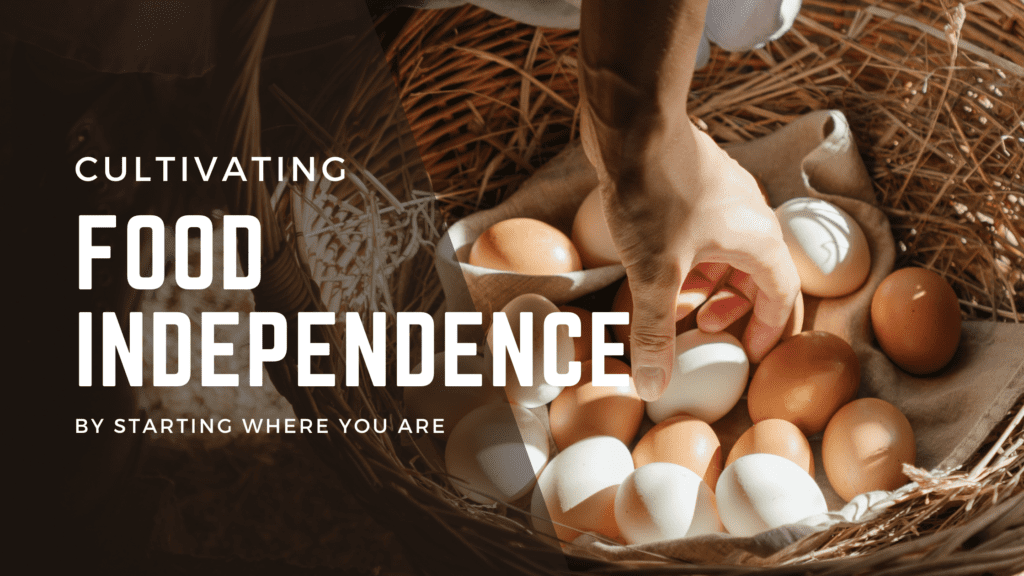Cultivating Food Independence

What is food independence?
When we speak of cultivating food independence, we are referring to the ability of an individual to produce and provide their own food, largely without relying on external resources. Does this mean that every bite of food that will ever cross our lips has been grown, preserved, and prepared by us? No, it would be nearly impossible for those of us living in the Appalachian Highlands zone 6 to grow and preserve one hundred percent of our own food. So how does one attain a higher level of food independence in the absence of the ability to “do it all”? The answer, while it sounds complicated, is actually quite simple. Let’s get into it.
Start Where You Are
Whether you’re on 100 acres in the country or perhaps in an apartment high in the sky, you can grow at least a portion of your own food. It may sound impossible to do this in a mid-city highrise, it isn’t. Even in the absence of balconies, one can still produce a good amount of food. This can be accomplished through such modern garden devices as hydroponic tower gardens or smaller versions which fit on countertops.
While you may not be capable of producing all of your own food through these growing methods, they are important first steps on the path towards food independence. For those who are living on acreage or even a small plot midtown, starting with raised beds may be your first step. The most important, and most difficult, step is to simply begin. Humble beginnings often yield the greatest rewards. Don’t allow your inability to “go big” to keep you home. Just start, pick something and begin. Herbs in your kitchen window, tomatoes grown in 5 gallon buckets, just pick your starting point and let’s get going.
“I Can’t Do It All”
We’re mind readers. We can hear you moaning these words all the way across the inter-webs as you read. What’s the first step to problem solving? Admitting that there is one. You’re correct, you cannot do it all, at least not alone. So what do you do? You keep starting, right where you are. Above we discussed small beginnings in producing your own food, now we will discuss the importance of community based agriculture. Most rural communities today have moved away from community-based agriculture, it seems. There appears to be a lack of understanding that through community, entire hyper-local supply chains can be built.
If you live in a rural community that has lost its way, let the rebuilding begin with you. Perhaps it begins on your street with yourself and your neighbors talking it over and agreeing to grow a few crops to sell to one another. Perhaps you are an epic pepper and garlic gardener while Susan next door grows the largest best tasting tomatoes and herbs in the county and Paul down the road is the master of all things squash and cucumber. If each of you agree to grow extra of the plants you excel at cultivating, you’ve created a small community-based agriculture system.
As you seek to grow this base, and it will grow because if you build it they will come, you are creating the hyper-local community-based supply chain that creates food independence. Remember what we said about humble beginnings? Most often, with persistence and hard work, these beginnings advance your purpose in ways you could never imagine. Start right where you are. Someone has to do it, so let it be you.
Three Actionable Steps You Can Take Today To Build Food Independence
- Plant 3 food items today. No matter how small they are. Pick 3 herb varieties, 3 tomatoes in buckets, 3 squash plants. It does not matter what those 3 items are, plant them. Plant 5 to be safe because if this is your first rodeo there is a high likelihood a few casualties could occur. Just try it. If 5 survive, fantastic, if 3 or even just 1 survives it will still be food you produced on your own.
- Learn to preserve food. Perhaps you’re terrified of a pressure canner, that’s okay learn to blanche and freeze or dehydrate food. We can move on to canning when you’re ready, the important part is that you are taking steps towards preserving food in some way. When you’re prepared to move on to pressure canning, we offer a step by step simple to follow video course and direct message support. You can do this, we’re here to help you.
- Get to know your local farmers and growers. The simple act of knowing the person who grows your food increases food independence as well as the nutrient density of the meat, dairy, and produce you consume. Hyper-localized foods are picked at peak ripeness and travel minutes not hours to arrive on your table. Studies have shown that food items harvested and prepared or preserved within hours not days can have up to 100% more of certain nutrients than those which were picked, stored, and shipped. With the focus today on nutrient density in our food resources, this action item is of key importance.
Join us at Superb Food Independence Summit
We along with friends such as Joel Salatin, and Justin and Rebekah Rhodes, will be speaking and teaching food preservation at the Superb Food Independence Summit in Millersburg, Ohio June 21-22, 2023. An exhibition of lecture, canning instruction, meat animal harvesting, and more will take place both days. The Appalachian Homestead Grandparents “Mam” and “Paw” will also be present to demonstrate open fire canning. Come join us, we’re here to teach and share
